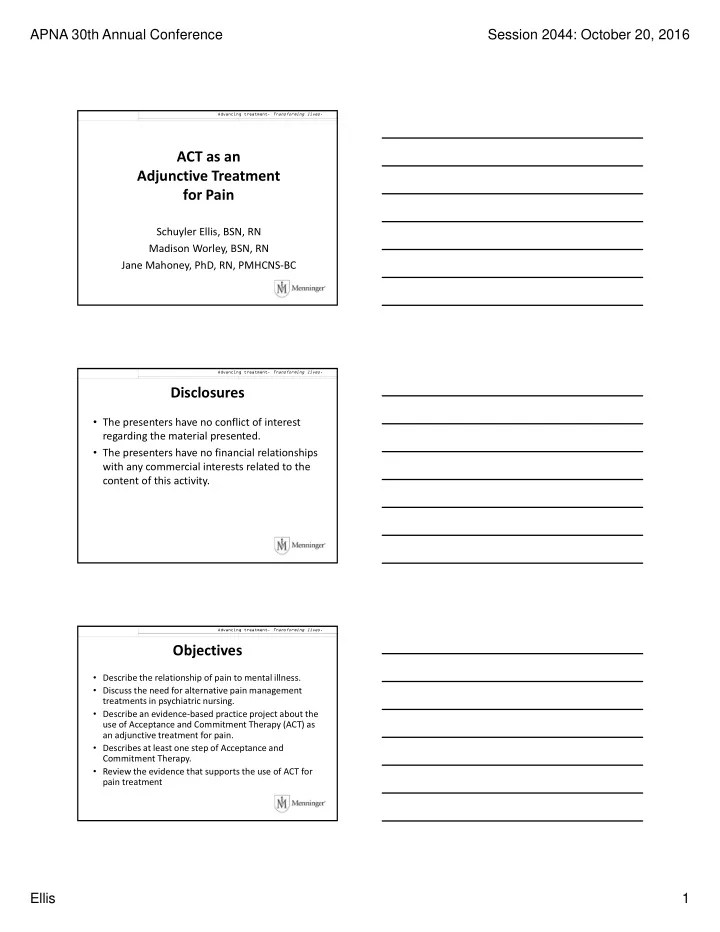

APNA 30th Annual Conference Session 2044: October 20, 2016 Advancing treatment. Transforming lives. ACT as an Adjunctive Treatment for Pain Schuyler Ellis, BSN, RN Madison Worley, BSN, RN Jane Mahoney, PhD, RN, PMHCNS ‐ BC Advancing treatment. Transforming lives. Disclosures • The presenters have no conflict of interest regarding the material presented. • The presenters have no financial relationships with any commercial interests related to the content of this activity. Advancing treatment. Transforming lives. Objectives • Describe the relationship of pain to mental illness. • Discuss the need for alternative pain management treatments in psychiatric nursing. • Describe an evidence ‐ based practice project about the use of Acceptance and Commitment Therapy (ACT) as an adjunctive treatment for pain. • Describes at least one step of Acceptance and Commitment Therapy. • Review the evidence that supports the use of ACT for pain treatment Ellis 1
APNA 30th Annual Conference Session 2044: October 20, 2016 Advancing treatment. Transforming lives. Multidimensional Aspects of Pain • Sensory ‐ discriminative • Affective ‐ motivational • Cognitive ‐ evaluative • Interactive but dissociable Advancing treatment. Transforming lives. Pain and Depression • Bodily aches and pains are a common symptom of depression. • Studies show that people with more severe depression feel more intense pain. – Due to increased cytokine levels – Cytokines promote inflammation – Signs of inflammation: pain, swelling, redness, heat, and sometimes loss of function Advancing treatment. Transforming lives. Pain and Quality of Life • Quality of life is sensitive to the treatment of pain • Pain affects most domains of quality of life • Effect of pain on QOL depends on: – Extent, Duration, Acuteness, Intensity – Affectivity, Meaning of the pain – Underlying disease – Individual's characteristics • Treatment of pain may be supported by a multidisciplinary, multi ‐ modalities approach that targets improvement of affected domains of QOL Niv & Krietler, 2001 Ellis 2
APNA 30th Annual Conference Session 2044: October 20, 2016 Advancing treatment. Transforming lives. Acceptance and Commitment Therapy • A psychological flexibility model • “Third wave” in behavioral and cognitive therapy • Definition – A psychological intervention based on modern behavioral psychology, including Relational Frame Theory, that applies mindfulness and acceptance processes, and commitment and behavior change processes, to the creation of psychological flexibility – The Association for Contextual Behavioral Sciences (S. Hayes) Advancing treatment. Transforming lives. Acceptance Committed Action Being Present ACT (Psychological Flexibility) Values Defusion Self ‐ As ‐ Context Advancing treatment. Transforming lives. PICO Question • In people with chronic pain, is ACT an effective adjunctive treatment? Ellis 3
APNA 30th Annual Conference Session 2044: October 20, 2016 Veehof et al., 2011 Level of Evidence: 1 Validity: Results: Systematic Review Studies included: Analysis groups stratified accordingly: & All studies Meta ‐ analysis Acceptance ‐ based interventions: Controlled studies (CCTs & RCTs) Acceptance & commitment CCTs Aim: therapy (ACT) RCTs To assess the effectiveness of ACT ‐ based interventions on patients with Mindfulness ‐ based stress Controlled studies (CCTs & RCTs) chronic pain reduction therapy (MBSR) Primary Outcomes Pain Intensity: 0.37; CI (0.20 – 0.53) Method: 9 Randomized Control Trials (RCT) Depression: 0.32; CI (0.13 – 0.50) Controlled & non ‐ controlled trials 5 Clinical Control Trials (CCT) 8 Other Study Designs relevant to Secondary Outcomes Primary outcomes study aim (OD) Anxiety: 0.40; CI (0.07 – 0.73) Pain intensity Physical Wellbeing: 0.35; CI (0.10 – Depression Quality was assessed using criteria 0.59) Secondary Outcomes recommended by Cochrane Quality of Life: 0.41; CI (0.16 – 0.65) Anxiety Collaboration and Jadad Scale Physical well ‐ being RCTs only Quality of Life RCTs – Medium to high quality (9) Primary Outcomes Sample: CCT & OD – Low to medium quality Pain Intensity: 0.25; CI (0.01 – 0.49) (13) Depression: 0.26; CI (0.05 – 0.47) 22 studies ‐ 1235 patients with chronic pain Pooled Standardized Mean Differences Secondary Outcomes to determine effect size Anxiety: 0.55; CI ( ‐ 0.09 – 1.18) Physical Wellbeing: 0.43; CI (0.04 – 0.82) Quality of Life: 0.25; CI ( ‐ 0.10 – 0.59) Öst, L., 2014 Level of Evidence: 1 Validity: Results: Systematic Review Studies included: Analysis groups stratified accordingly: & All studies Meta ‐ analysis 3 ACT intervention components Somatic studies Aim: Randomly allocate participants to All studies Update systematic review and meta ‐ treatment and control or to two or Psychiatric disorders, somatic analysis of Öst, 2008 more treatments disorders, and stress at work Compare methodological stringency Quality of studies: Effect size: g = 0.42 and effect size of earlier studies (2008) Assessed by using self ‐ developed Indicating a small effect size with that of later studies (post 2008) quality scale Somatic Studies Evaluate the evidence ‐ based status of Inter ‐ rater reliability Effect size: g = 0.43 ACT for the different disorders for Internal consistency (Cronbach’s Indicating a small effect size which it has been tried alpha = 0.81) Pain Comparison of ACT vs CBT in a large Analysis: Probably efficacious treatments sample of studies Multiple levels of analysis to support rigor of meta ‐ analysis At least two good experiments Method: showing that the treatment is superior Randomized Controlled Trials: Hedge’s g used to determine effect (statistically significant so) to a wait ‐ Psychiatric Disorders size list control group, or Somatic Disorders Appropriate test for effect size Stress at Work Situations when sample size is relatively One or more good experiments small meeting the well ‐ established Sample: treatment criteria with the one 60 Randomized control trials exception of having been conducted 4234 ti t Advancing treatment. Transforming lives. PICO Question In people with chronic pain, is ACT an effective adjunctive treatment? Emerging body of research suggests it is reasonable to use ACT as an adjunctive treatment for pain. Ellis 4
Recommend
More recommend